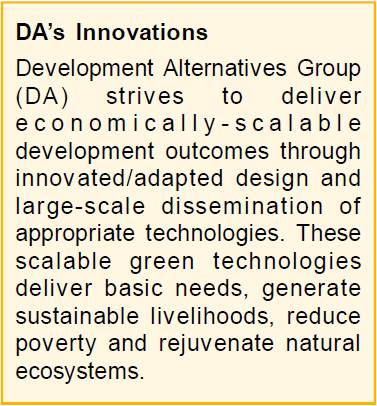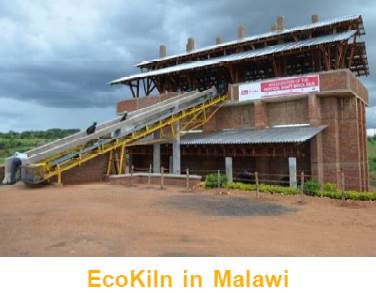|
Lab to the Market: A n innovation effectively means translating an idea or invention into a good or service which creates value for the customers. The mandate of the Development Alternatives (DA) Group is to innovate and incubate scalable solutions, models and businesses to deliver triple bottom line benefits.What is a Successful Innovation? To be called a successful innovation, Development Alternatives believes that the idea must be replicable at an economical cost and satisfy a particular expressed need i.e. must be demand based. Innovations of course help businesses cater to a market demand but in a broader social context, they help create methods for collaborations, joint venturing and creation of buyers’ purchasing powers 1.There is an increasingly popular viewpoint in the innovation world that behaviour is the unknown variable that determines the success of an innovation. We are at the end of an era that focused entirely on innovations of products and services and transitioning to an era that focuses on ‘behavioural business models’ 2. eBay has changed online auctioning to a community experience, Google has changed our interactions with the internet through its search engines and developing energy programmes for economic development is changing the face of rural electrification. This new era is focusing on the why of the innovation as opposed to what we can make cheaper/better/faster3. And the question of why is always tied to the question of how markets behave.Where do Good Innovations go? Ideally, good innovations go from the lab to the market i.e. a good innovation sees movement from a prototype to a pilot to a scalable, revenue-generating model. This movement happens when organisations have the flexibility to depart quickly from their planned trajectory, jump onto new opportunities that take an active role in introducing new behaviours where there were none previously. Innovative organisations are the ones with the know-how to facilitate this movement. They develop collaborative models that ultimately integrate the market into the process of innovation and where the market feedback is regularly taken into account. This however does not mean that organisations are held hostage by their customers. It just means that the organisations push the envelope based on market behaviour to know where innovations can add value in unexpected ways. The current innovative environment is developing so rapidly that while technology and behaviours might change incrementally on the margins for long periods of time, leading innovators from around the world are approaching breakthroughs that are disrupting established players. This is seen in the telecommunications sector in India, in energy markets around the world and in e-commerce. The rise of wireless technology fundamentally altered tele-communications. Water ATMs have cropped up changing the role that private players can play in rural service provision 4.Going from the Lab to the Market: A Tale of Impacts, Money and Change The motivation for taking innovations from the lab to the market i.e. commercialisation goes beyond just generating revenue and making profit. Innovative solutions in this article are primarily looking to resolve global sustainability challenges. They are cost-effective alternatives that will benefit vulnerable populations and the environment without requiring long-term public or philanthropic support; that have sound business plans and potential to generate sustainable profits. The scalability of such solutions then demonstrates explicitly their impacts and effectiveness 5.In order to integrate the market feedback with an organisation’s innovation process, creating a robust system is necessary. An example of this is DA’s Innovation-Incubation Engine (In2E)©. The In2E is crucial to the organisation’s mandate of creating scalable solutions to deliver triple bottom line benefits, as it takes innovations through a fairly rigorous process of checks, balances and proof of viability to demonstrate a sound business potential. Commercialisation of innovations – be at a nascent stage of establishing intent or at a later stage of scaling up for impacts – should have an institutionalised process within an organisation. A process that is complimented by human resources, functional management and facilities and has been designed to streamline the process from the development of a technology to large scale dissemination. The process starts with development of market-based solutions and models by focusing on desired technical performance targets and ends with the incubating entity which ensures faster delivery of solutions through robust mechanisms, local value chain and feedback loops. The scaling-up eco-system also applies a multi-stakeholder approach to commercialisation of eco-solutions through working with partners and experts at different stages and levels. This multi-stakeholder approach also helps with risk management where technology, environmental and social risks can be identified at an early stage through brainstorming sessions. Experts from various fields critically analyse risks that can cause an innovation or a business model to fail. Case Study – Building for Sustainability
One of the innovations adapted and successfully scaled up by the DA group is the TARA EcoKiln. The EcoKiln was promoted as a small capacity, flexible technology which was an energy efficient option for greening the brick industry. TARA EcoKiln in India was launched in 1995 by DA and the Swiss Agency for Development and Cooperation (SDC) to introduce sustainable production systems for building materials. It was demonstrated in Datia, Central India after customising a technology package from neighbouring countries to suit the local conditions. The pilot EcoKiln catered to the evolving needs of the local brick industry. In order for any innovation to be viewed positively, the target audience – in this case the local entrepreneurs – had to visualise a strong market potential. Apart from reduced emissions, profitability of around 20% from reduced coal and labour savings was also achieved. Entrepreneurs were interested in adopting the same due to enhanced profits and compliance with environmental standards. Regulatory agencies have been interested in enforcing the same since environmental compliance is maintained with. The successful demonstration created significant interest amongst all the major stakeholders in the brick industry. With the technology validated with a pilot demonstration while achieving performance, a financial analysis done after running the kiln for a few months proved the technology to be better than the established traditional clamps. A technology package was created around the EcoKiln to make it replicable across various geographies. The technology package used local resources for hardware, raw material, specialised material, construction and commissioning; local human resources for maintenance and operation certification. This use of local resources throughout the supply chain and understanding of the local market helped in the smooth functioning of the existing pilot units as well as scaling up of new ones. Since 1995, the TARA EcoKiln technology package has been replicated in Nepal, Bangladesh, Sri Lanka, South Africa, Indonesia and Malawi. Within a span of 12 years (2000-2012), more than 150 EcoKilns have been established in a commercial mode producing premium quality bricks across India. q Rowena Mathew Saksham Nijhawan Endnotes 1 The Business Dictionary 2 INSEAD. 2014. 3 Koulopoulos. 2012. "Cloud Surfing: A New Way to Think about Risk, Innovation, Scale and Success" 4 McKinsey & Co. 2012. "10 disruptive technologies" 5 Global Innovation Fund
|

